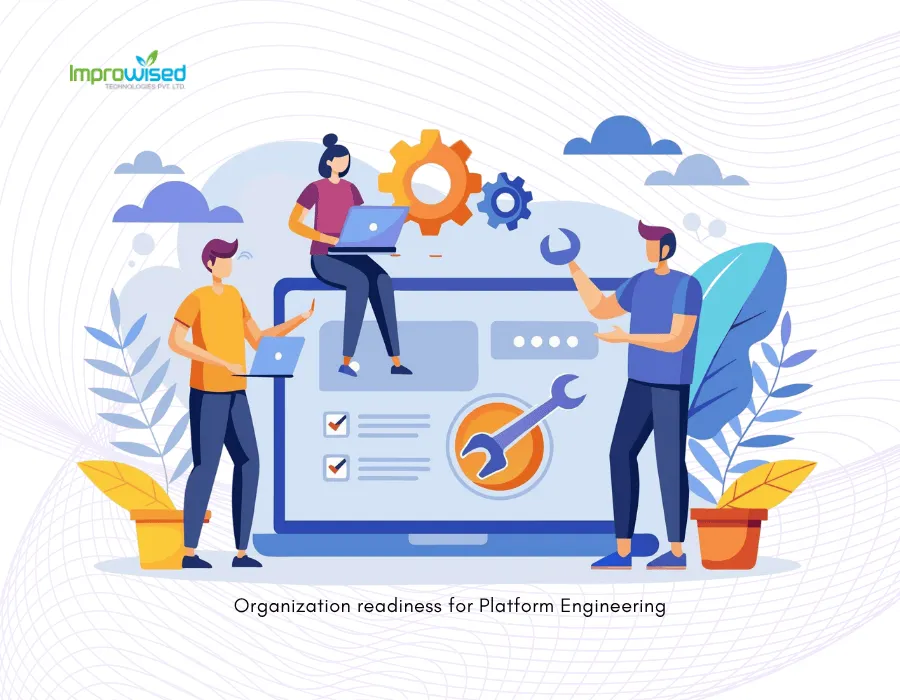November 10, 2025
Guide on Successful Internal Developer Platform: Best Practices, Benefits, and Use Cases

By Shyam Kapdi
Improwised Technologies Pvt. Ltd.
Internal Developer Platforms power today’s tech teams - not due to hype, but because building software now goes way beyond old-school DevOps setups. Speed gives companies an edge, even as systems get tougher: think multiple clouds, Kubernetes sprawl, scattered services, strict rules to follow, along with tight safety checks.
This is the spot where IDPs come in - giving teams one clear, do-it-yourself route to launch, smoothing out messy ops so coders can focus on creating stuff instead of fighting servers.

Inside tech firms, developer platforms link coders to tricky cloud setups - these systems get managed by dedicated engineers who keep things running smoothly. When companies grow fast and their toolkits scatter across services, these internal hubs start mattering a lot - they speed up work while bringing pieces together.
We’ll walk through real-world examples, no-fluff advantages, plus solid tips drawn from actual rollouts - all aimed at creating tools that help devs move quicker instead of slowing them down.
What is an Internal Developer Platform?
A single IDP acts like a hands-on toolkit - put together thoughtfully - that bundles setup steps, software helpers, and automated tasks to cut down busywork and mental clutter, so coders can zero in on building useful stuff. Instead of just being a hub for guides and system links - or standing in for wide-ranging platform teams - the IDP runs the actual machinery that coordinates actions, manages flow, and enforces rules behind the scenes. These modern, cloud-built platforms hook directly into systems managing containers (think Kubernetes), pipelines for testing and deploying code, monitoring setups, along safety checks. Tools you might recognize include open options like Spotify’s Backstage, or paid ones such as OpsLevel and Qovery - all different in how they expand and manage control
An IDP isn’t just a starting page like a Developer Portal, nor is it the wide approach of Platform Engineering Services - instead, it’s the working setup that powers automation, lets teams handle resources on their own, while keeping rules steady across the board
Key Components of an Internal Developer Platform
The anatomy of a successful IDP can be summarized through these core components:
- Infrastructure Orchestration: Manages resources, lifecycles, and environments securely and scalably (often using Kubernetes).
- Developer Experience Layer: Offers self-service interfaces, templates, and golden paths (or “paved paths”) for standardized delivery, freeing devs from repetitive, manual tasks.
- CI/CD Automation: Integrates code builds, tests, and deployments, ensuring streamlined and consistent delivery backed by automation.
- Security and Compliance: Embeds guardrails (policy-as-code, role-based access, auditability) directly into developer workflows, non-negotiable in regulated or high-scale environments.
Best Practices for Building and Using an Internal Developer Platform
A strong IDP shows up once engineering squads start thinking like product builders. Seeing the IDP as something people use - not just build - shifts focus toward steady updates, clear plans, input from users, live data tracking, plus designs built around devs’ real needs. Good IDPs push easy access tools, though freedom works better when paired with safety limits. Manual setup by coders? That’s off the table - pick ready-made, locked-down choices that follow proven standards instead.
- Developer Experience First: An IDP should feel intuitive and frictionless for engineers, providing rich self-service capabilities, easy environment provisioning, and minimizing the cognitive load with smart defaults.
- Balanced Automation vs Control: Automation should reduce manual steps but enable necessary overrides and transparency for platform teams-avoiding “black boxes”.
- Security by Design: Compliance and security rules must be embedded in every workflow and enforced automatically.
- Continuous Improvement & Feedback Loops: Teams must treat their IDP as an evolving product, using developer feedback and usage data to refine and extend capabilities continuously.
- Use of Top Developer Experience Tools: Platforms like Backstage, Humanitec, and OpsLevel champion modular design and developer-centric features, illustrating how today’s best-in-class IDPs blend automation with usability.
Benefits of an Internal Developer Platform
A well-designed IDP delivers game-changing advantages across the organization:
- Boosted Developer Productivity: Minimize manual setup and troubleshooting, letting engineers focus on code.
- Faster, More Reliable Delivery: Streamlined CI/CD accelerates releases and drastically reduces lead times.
- Consistency with Flexibility: Enforce standards, security policies, and compliance, but allow customization per team or use case.
- Enhanced Team Collaboration: Platform engineering and product teams work together in a shared ecosystem, breaking down silos and clarifying ownership.
Use Cases and Real-World Examples
Cloud-native firms rely on IDPs to handle short-lived setups, run Kubernetes over many clusters, while tying in GitOps flows through smooth pipelines. Different clouds get simplified by IDPs - this lets dev teams push apps without hassle, whether they’re using AWS or jumping between Azure and GCP. Industries under strict rules apply IDPs to bake in compliance early, keep clear logs, also trigger automated policies when needed. Every scenario uses IDPs to fix scattered systems, speed up releases, plus cut down day-to-day risks.
Spotify’s Backstage stands out as one of the first IDPs. Built to bring together countless microservices and homegrown tools, it eventually turned into open-source software managing cloud setups across providers while speeding up service rollouts far and wide. That shift reveals how an IDP might start as just a dev hub but mature into a solid platform engineering solution.
Some groups use IDPs to handle messy multi-cloud setups, boost team happiness with instant access to test spaces, while also meeting strict rules in tightly controlled sectors. These cases show how useful a smart IDP can be across different fields.
Common use cases include:
- Cloud-Native Software Delivery: Multi-cloud orchestration, ephemeral test environments, and auto-scaling deployments.
- Multi-Cloud/Hybrid-Cloud Engineering: IDPs abstract infrastructure across AWS, Azure, GCP, and on-prem for global teams, enabling single-click operations and policy controls.
- Platform as a Product: Where platform teams run their platform as an internal product, gathering usage metrics and feedback to iterate on features.
- Regulated Industries: Automated compliance reporting, sandboxed environments, and traceable deployments.
Choosing the Right Internal Developer Platform Tools
Picking the best IDP tools starts with knowing how your team builds software. Options such as Backstage, Humanitec, Port, Crossplane, AgroCD, Terraform, or Pulumi come up a lot - yet going with one just because it’s trendy isn’t smart.
The actual deciding points? How smoothly it fits with your current workflow, if it makes things easier on developers’ minds, or if it meets your security and compliance rules. Open-source setups give freedom, yet need skilled crews to set up and manage them - commercial options speed up rollout, yet gotta match your standard processes well. Kick off by looking at how you work now, then pick the right tools afterward, not before.
- Popular Tools to Consider:
- Backstage: Leading open-source platform emphasizing customization and extensibility.
- Port: Commercial with strong governance and developer self-service features.
- Qovery: Cloud-native automation focused on abstracting Kubernetes complexity.
- Humanitec: Unified infrastructure dashboards and fast delivery cycles.
- Choreo: AI-powered, all-in-one solution with CI/CD, API management, and security.
- Evaluation Criteria:
- Integration Flexibility: Support for CI/CD, Kubernetes, GitOps, and cloud-native tools.
- Developer Autonomy & Governance: Enable self-service while enforcing policies.
- Customization & Extensibility: Platform should adapt to your organization’s unique needs.
- Community & Support: Prefer active open source communities or reliable commercial vendors.
- Ease of Use: User experience and onboarding speed are key for adoption.
- Open Source Options:
- Backstage: CNCF-backed project with rich plugin architecture and a global community.
- Port (OSS components): Offers SDKs and integrations blending community and commercial benefits.
- Emerging Projects: Keep an eye on new open source tools targeting specific IDP capabilities.
Conclusion
Internal Developer Platforms aren’t just nice-to-haves anymore - they’re essential if you want faster software releases, happier developers, while still keeping things under control. This change moves teams away from doing DevOps by hand toward strong platform engineering built for modern cloud setups, multiple clouds, or strict compliance needs. Companies that step into this shift - especially when they get smart help setting it up - can gain a real edge over others.
Improwised Technologies is prepared to team up - offering tailored platform builds so your IDP path hits full potential.
Frequently Asked Question
Get quick answers to common queries. Explore our FAQs for helpful insights and solutions.

November 7, 2025
How to Troubleshoot Kubernetes: Identify and Fix Issues Like a Pro

By Shyam Kapdi
Improwised Technologies
Pvt. Ltd.

November 5, 2025
7 Signs Your Organization Needs Platform Engineering

By Priyank Dhami
Improwised Technologies
Pvt. Ltd.


By Shyam Kapdi
Improwised Technologies
Pvt. Ltd.
Optimize Your Cloud. Cut Costs. Accelerate Performance.
Struggling with slow deployments and rising cloud costs?
Our tailored platform engineering solutions enhance efficiency, boost speed, and reduce expenses.
